|
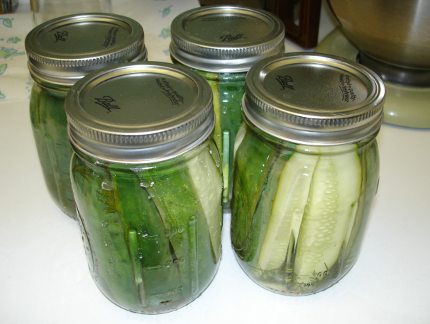 I love dill pickles. I eat a lot of them. I'll have them with a salad, or with a sandwich or burger, or sometimes alone as a snack.
One day I saw a bin full of mini cucumbers at a produce market I frequent and got the idea of making my own dill pickles.
I love dill pickles. I eat a lot of them. I'll have them with a salad, or with a sandwich or burger, or sometimes alone as a snack.
One day I saw a bin full of mini cucumbers at a produce market I frequent and got the idea of making my own dill pickles.
I started, as
I always do, by doing some research. I looked at the list of ingredients on a brand of store-bought pickles I particularly liked.
It was a short list, just cucumbers, water, vinegar, garlic and salt. It looked simple enough, but the ingredient list didn't
tell me what proportions to use. So I went to the internet to find more information. I found lots of recipes, and naturally they
were all quite different. So I just chose a couple more or less at random, and gave them a try. They were pickles, but not as good
as my favorite store-boughts. Time to tweak the recipe. I tried several variations (and made a few mistakes). I'd make up a batch
of pickles and try a side by side taste test with my favorite store bought pickles to try decide what needed to be changed for the
next batch. In the end, I came up with a recipe that I really like. I've been eating my own pickles for a couple of months now, and
may never get around to opening my last jar of store-bought pickles. I guess I'll keep it in the pantry for a "pickle emergency."
This recipe makes refrigerator pickles. They should keep in the refrigerator for a month or two (pickles never last that long in my fridge
because they get eaten quickly). For longer term storage, they can be
processed with standard canning techniques. Canning will give them a shelf life of years, and I think somewhat improves the flavor, but
at the cost of some crispness in the pickles. I'll talk more about canning below. Let's make some pickles.
This recipe will make 2 pint jars of dill pickles. Multiply it to make larger batches.
| 8-10 4in long Cucumbers |
2 cloves of garlic |
| 2 small sprigs of fresh dill weed |
2 tablespoons Kosher or pickling salt |
| 1 cup white distilled vinegar |
2 cups water |
| 1/2 teaspoon whole mustard seed |
2 1-pint Mason jars |
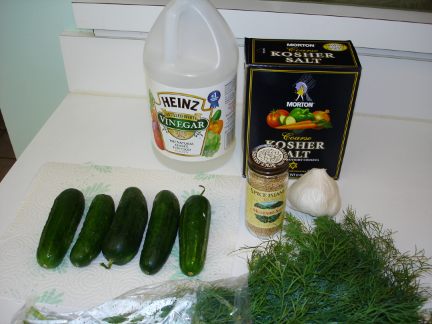 I
Here is everything needed to make some dill pickles. I made four jars of pickles this day, so basically I doubled everything above. Only a few of the total
number of necessary cucumbers is shown in the photo. All the other ingredients, the vinegar, salt, mustard seed, garlic and dill are also shown. All
are really easy to find in any supermarket, except for the dill. Avoid dried dill and the prepackaged green dill from the supermarket unless you can't
find fresh dill anywhere. I get my dill from the same fresh produce market where I get my cucumbers. They have all kinds of wonderful fresh herbs there,
including big bunches of fresh dill for under $2. I also grow my own dill in my small patio herb garden, but rarely have enough on hand for a big batch
of pickles. So I usually have to buy some from the produce market. FYI, if you are a gardener, or want get into gardening, dill is a good herb to
grow in a raised bed garden. I
Here is everything needed to make some dill pickles. I made four jars of pickles this day, so basically I doubled everything above. Only a few of the total
number of necessary cucumbers is shown in the photo. All the other ingredients, the vinegar, salt, mustard seed, garlic and dill are also shown. All
are really easy to find in any supermarket, except for the dill. Avoid dried dill and the prepackaged green dill from the supermarket unless you can't
find fresh dill anywhere. I get my dill from the same fresh produce market where I get my cucumbers. They have all kinds of wonderful fresh herbs there,
including big bunches of fresh dill for under $2. I also grow my own dill in my small patio herb garden, but rarely have enough on hand for a big batch
of pickles. So I usually have to buy some from the produce market. FYI, if you are a gardener, or want get into gardening, dill is a good herb to
grow in a raised bed garden.
 These are the sort of cucumbers I like for making pickles. They are about 4 inches long and no more than about 1 1/2 inches in diameter. They are
dark green, firm and warty. Get them as fresh as possible. Reject the pale, yellow, blemished and mushy ones. Avoid the shrink-wrapped ones at your
local supermarket unless they are your only option. You never know how long they have been wrapped up, which just makes them go bad quicker. Also,
they always wrap them with the best looking side of the cucumbers facing up. You don't know what you are really getting until you get home and unwrap them.
If possible get your cucumbers from a farmer's market or produce market with really fresh stock. If they are in season where you live, you can always go pick
your own at a you-pick farm.
These are the sort of cucumbers I like for making pickles. They are about 4 inches long and no more than about 1 1/2 inches in diameter. They are
dark green, firm and warty. Get them as fresh as possible. Reject the pale, yellow, blemished and mushy ones. Avoid the shrink-wrapped ones at your
local supermarket unless they are your only option. You never know how long they have been wrapped up, which just makes them go bad quicker. Also,
they always wrap them with the best looking side of the cucumbers facing up. You don't know what you are really getting until you get home and unwrap them.
If possible get your cucumbers from a farmer's market or produce market with really fresh stock. If they are in season where you live, you can always go pick
your own at a you-pick farm.
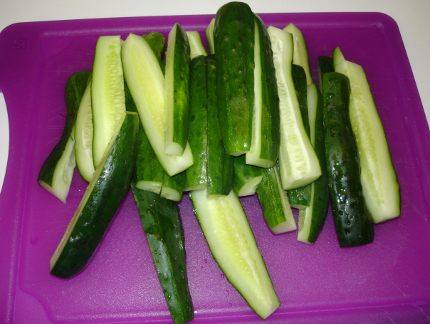 Scrub the cucumbers thoroughly (they grow in the dirt you know). I cut a little off of each end to get rid of the blossom and stem nubs.
Then I like to slice my cucumbers into quarters. I'll cut especially fat cucumbers into 6ths or 8ths just to keep the sizes of the slices roughly uniform.
You can also do halves or wholes or slice them into rounds. I just happen to like quarters. Here is a pile of sliced cucumbers ready to be
packed into jars.
Scrub the cucumbers thoroughly (they grow in the dirt you know). I cut a little off of each end to get rid of the blossom and stem nubs.
Then I like to slice my cucumbers into quarters. I'll cut especially fat cucumbers into 6ths or 8ths just to keep the sizes of the slices roughly uniform.
You can also do halves or wholes or slice them into rounds. I just happen to like quarters. Here is a pile of sliced cucumbers ready to be
packed into jars.
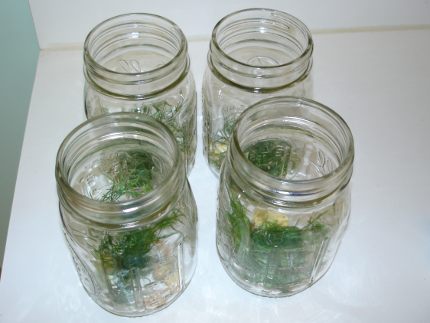 I start by running the Mason jars, lids and rings through a sterilize cycle in my dishwasher, then pulling out only what I need, when I need it.
I prep the jars by adding a clove of garlic, a small bunch of dill, and 1/4 teaspoon of the whole mustard seeds to each before packing in the
cucumbers. I like to just lightly crush the garlic clove. Really mashing it, chopping it, mincing it or otherwise widely dispersing it will result
in much more garlicky pickles.
If that is what you want, then go for it. You might want to experiment and see how much garlic flavor is the right amount for you.
I start by running the Mason jars, lids and rings through a sterilize cycle in my dishwasher, then pulling out only what I need, when I need it.
I prep the jars by adding a clove of garlic, a small bunch of dill, and 1/4 teaspoon of the whole mustard seeds to each before packing in the
cucumbers. I like to just lightly crush the garlic clove. Really mashing it, chopping it, mincing it or otherwise widely dispersing it will result
in much more garlicky pickles.
If that is what you want, then go for it. You might want to experiment and see how much garlic flavor is the right amount for you.
Speaking of experimenting,
you may need to experiment with the amount of dill. I put a small bunch in. It's hard to describe the amount. Just several good bushy sprigs, but
not too much. The first batch of pickles I made had way too much dill in it. They tasted weird. I cut way back on the dill in later batches and was
much happier with the result.
The mustard seed is added because I like the slight mustardy flavor they impart to the pickles. In my early side by side
taste tests between my pickles and my favorite store-bought pickles, I decided that the store-boughts had a slight mustardy taste, even though mustard was
not listed as an ingredient. I started adding a little to my pickles and was very happy with the result.
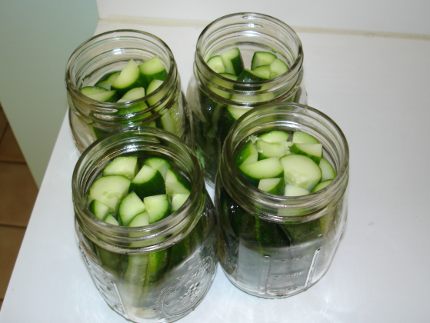 Now it is time to pack the cucumber slices into the jars, and I do mean pack. The slices should be packed tightly into the jars.
don't leave a lot of empty space in the jars or the pickles will be too salty and tart. The natural juices in the cucumber slices are going to dilute the
salty and acidic brine we will be filling the jars with. Failing to pack the jar tightly with cucumbers, or using a jar with too much head space,
will result in pickles that are too salty and tart.
Now it is time to pack the cucumber slices into the jars, and I do mean pack. The slices should be packed tightly into the jars.
don't leave a lot of empty space in the jars or the pickles will be too salty and tart. The natural juices in the cucumber slices are going to dilute the
salty and acidic brine we will be filling the jars with. Failing to pack the jar tightly with cucumbers, or using a jar with too much head space,
will result in pickles that are too salty and tart.
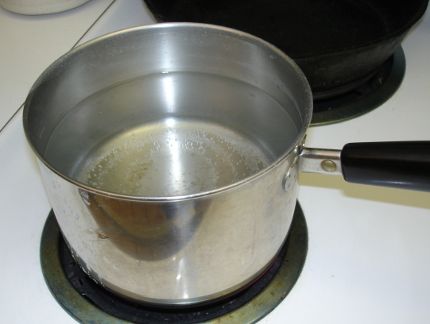 Combine the water, vinegar and salt in a non-reactive saucepan. Non-reactive basically means use stainless steel. Copper, aluminum and cast iron cookware
will be attacked by the salty, acidic brew and bad-tasting metals will be leeched into the brine. You don't want that. Bring the brine to a boil, stirring
now and then to ensure all the salt dissolves.
Combine the water, vinegar and salt in a non-reactive saucepan. Non-reactive basically means use stainless steel. Copper, aluminum and cast iron cookware
will be attacked by the salty, acidic brew and bad-tasting metals will be leeched into the brine. You don't want that. Bring the brine to a boil, stirring
now and then to ensure all the salt dissolves.
 Fill the packed jars up to the bottom of the jar neck with the hot brine. A canning funnel may come in handy for this. I usually just do it
in my sink so if I get sloppy it doesn't make a mess. Give the jars a minute or two for the air between the slices to bubble up to the top,
then top off the jars with more brine back up to the bottom of the neck. Basically you want to just submerge the cucumber slices. Don't fill
the jars to the top. There needs to be an air space. Wipe down the tops of the jars to ensure a good seal. Put on lids and screw down the rings
good and tight. If you are making refrigerator pickles, you are done! Let them cool down to room temperature, then stash them in the fridge for
about 5 days (if you can wait that long) before eating them. That will give them time for the pickling process to fully run its course.
Fill the packed jars up to the bottom of the jar neck with the hot brine. A canning funnel may come in handy for this. I usually just do it
in my sink so if I get sloppy it doesn't make a mess. Give the jars a minute or two for the air between the slices to bubble up to the top,
then top off the jars with more brine back up to the bottom of the neck. Basically you want to just submerge the cucumber slices. Don't fill
the jars to the top. There needs to be an air space. Wipe down the tops of the jars to ensure a good seal. Put on lids and screw down the rings
good and tight. If you are making refrigerator pickles, you are done! Let them cool down to room temperature, then stash them in the fridge for
about 5 days (if you can wait that long) before eating them. That will give them time for the pickling process to fully run its course.
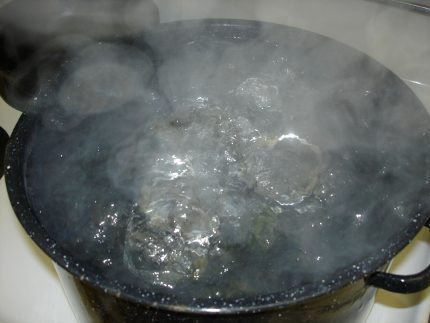 Another option is to properly can the pickles for long-term storage. This is a great way to make pickles in bulk and have them throughout the year.
Follow the above directions. Once you have the jars packed and sealed, just process them in a canning kettle at a rolling boil for 10 minutes. Canning
tongs and/or a wire basket for the kettle are essential for getting the jars in and out of the kettle without dropping them and splashing boiling hot
water and/or pickle juice and broken
glass around your kitchen and on yourself. Believe me, I learned this the hard way. This photo shows four jars in the canning kettle, though it is hard
to see through all the steam that came out when I took off the lid.
Another option is to properly can the pickles for long-term storage. This is a great way to make pickles in bulk and have them throughout the year.
Follow the above directions. Once you have the jars packed and sealed, just process them in a canning kettle at a rolling boil for 10 minutes. Canning
tongs and/or a wire basket for the kettle are essential for getting the jars in and out of the kettle without dropping them and splashing boiling hot
water and/or pickle juice and broken
glass around your kitchen and on yourself. Believe me, I learned this the hard way. This photo shows four jars in the canning kettle, though it is hard
to see through all the steam that came out when I took off the lid.
After processing, set the jars out on a tea towel to cool. As they approach room
temperature, the lids should seal down tightly as a partial vacuum forms in the jar. You may hear loud pinging sounds as the seals suddenly bow inward.
once the jars have cooled, check all the lids. They should all be bowed in. Any that are still popped up aren't properly sealed. Put those jars in the
fridge and use those pickles within a month or two. The rest will keep indefinitely if stashed away in a cool dark place. I find that the canned
pickles are not quite as crisp as the refrigerator pickles because the canning process partially cooks and softens the cucumbers. However, I think the
flavor of the canned pickles is a little better than the refrigerator pickles.
Variations: There are lots of possible variations on this basic recipe. I have already talked about cutting the cucumbers in different ways
and varying how garlicky the pickles are by how much the garlic clove is mashed or minced. That just scratches the surface. Try adding a few cracked
peppercorns to the jars before packing and filling them. I like the peppery bite this imparts to the pickles. Try adding other spices of your choice
to the mix. Some people like to add a jalapeno pepper or two to the jars to make hot dill pickles. My mom likes to pickle her cucumbers with
sliced onions included. I haven't even touched on sweet pickles. The possibilities are endless.
I hope you like this dill pickle recipe as much as I do.
Enjoy!
See Also: My recipe for chili.
|




|